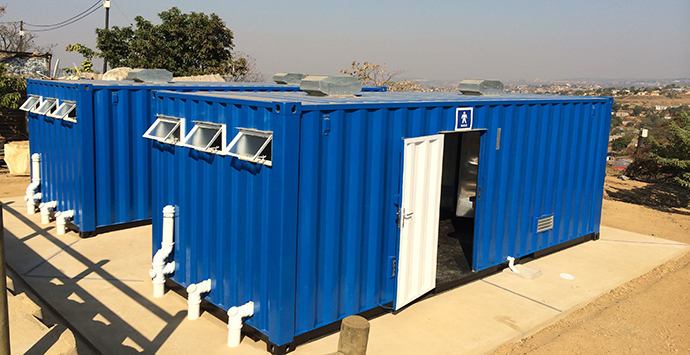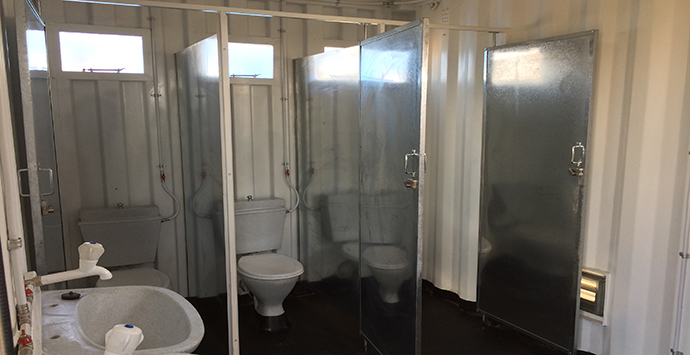We can’t wait: Solving the world’s sanitation crisis on a global scale
On November 19, in response to the U.N.’s World Toilet Day call to action, AECOM process engineer Ruth Cottingham discusses her work improving sanitation in Durban, South Africa.
One of the most memorable toilets I’ve ever experienced was on a nature reserve in South Africa, an hour’s drive from Durban. The facility, an open-front hillside shelter over a long drop toilet, offers a glorious view of the river valley below. Birdsong, a gentle breeze and the scent of spring flowers complete the picture of toilet serenity.
Unfortunately beauty and peace, or even just basic hygiene and safety, are not the reality for the 2.5 billion people around the world who today lack access to clean, safe sanitation facilities. In some communities, what serves as a toilet may just be a rancid hut or a poorly fenced-off area in an outdoor yard. Latrine pits overflow into nearby homes during the rainy season; rubbish and used sanitary pads block up toilets at schools; a flimsy superstructure wobbles over a stinking drain; and a mass of larvae huddles inches beneath a fetid squatting plate.
Access to sanitation facilities is crucial for meeting our basic human needs. The consequences of this are well documented: otherwise-preventable death, chronic disease and loss of earning potential are ravaging societies all over the world. Without access to feminine-hygiene products and adequate toilet facilities, young girls must miss school for days at a time each month, or even drop out entirely. Current facilities have led to environmental degradation, increased vulnerability to assault and rape and a fundamental loss of human dignity.
The scope of the problem is staggering, but so is the difference we can make by implementing solutions at scale.
The eThekwini municipality in South Africa, which includes Durban, takes sanitation seriously: its water and sanitation department won the 2014 Stockholm Industry Water Award for “its transformative and inclusive approach to providing water and sanitation services”[1]. The municipality provides water and sanitation services to more than three million people living in a wide range of circumstances, from rural areas with little infrastructure to wealthy city suburbs and dense, informal urban settlements. As a result, a variety of sanitation solutions exist, including conventional flush toilets, septic tanks, ventilated improved pit latrines, urine diversion toilets and community ablution blocks.
 Completed containerised ablution blocks (AECOM Informal Settlements Sanitation Project Team)
Completed containerised ablution blocks (AECOM Informal Settlements Sanitation Project Team)
We in AECOM’s Durban office have helped the city provide sanitation services to thousands of people living in informal settlements. Housing is typically dense and built on steep slopes, with dwellings constructed from roof sheeting, timber and other salvaged materials. Due to these conditions, community ablution blocks — modified shipping containers that include toilets, showers, hand-wash basins, communal standpipes and clothes-washing troughs — were determined to be the most appropriate solution in these areas. AECOM’s team in Durban designed and supervised the installation of almost 190 ablution blocks, which now provide potable water and hygienic sanitation to more than 50,000 previously unserved people.
 Inside one of the new ablution blocks (AECOM Informal Settlements Sanitation Project Team)
Inside one of the new ablution blocks (AECOM Informal Settlements Sanitation Project Team)
But access to toilets is not enough: the waste collected in them must be disposed of safely and, if possible, while recovering valuable resources along the way. My work as a chemical engineer has spanned multiple sanitation systems in varied contexts, and I’m currently working on upgrading one of Durban’s main wastewater treatment works. Today, the works discharges wastewater to the sea after only basic screening. The upgrade will separate solids from the wastewater and treat them, improving the marine environment.
Prior to joining AECOM, I worked on the sanitation system for dry-pit toilets used by over 100,000 households in the municipality. Our team developed a whole-cycle financial model to determine where an investment in the system would yield the greatest impact and how optimising operating conditions could reduce costs. We also looked at nutrient recovery from waste through a dehydration-pasteurisation process that results in a fertiliser[2].
Solving the world’s sanitation crisis is an immense challenge. It’s imperative that we work on developing solutions covering the whole sanitation cycle — from toilet to end disposal — and that we implement them successfully at scale. In the apt words of the U.N., in their tagline for World Toilet Day: we can’t wait.
 Ruth Cottingham is a process engineer with AECOM’s water business line in Durban, South Africa. She has worked on sanitation projects in Mozambique and South Africa and enjoys the challenge of trying to make sanitation happen at scale across all the different fields of work and the variety of people that are involved. When not searching for the perfect toilet, Ruth enjoys making the most of South Africa’s beautiful outdoors.
Ruth Cottingham is a process engineer with AECOM’s water business line in Durban, South Africa. She has worked on sanitation projects in Mozambique and South Africa and enjoys the challenge of trying to make sanitation happen at scale across all the different fields of work and the variety of people that are involved. When not searching for the perfect toilet, Ruth enjoys making the most of South Africa’s beautiful outdoors.
LinkedIn: Ruth Cottingham
References:
(1) Stockholm International Water Institute http://www.siwi.org/prizes/stockholmindustrywateraward/winners/2014-2/
(2) Pollution Research Group, University of KwaZulu-Natal – Current projects http://prg.ukzn.ac.za/projects/current-projects/economic-evaluation-of-faecal-sludge-disposal-routes






